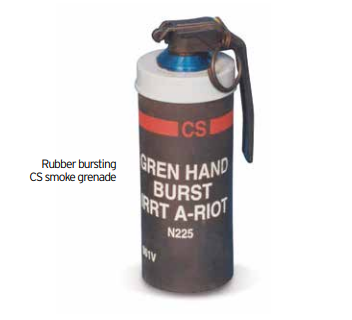Hong Kong protests: Police use ‘UK-made tear gas’ in violent crackdown on activists
Police criticised for using rubber bullets, pepper spray, tear gas and batons to force crowds back


Police in Hong Kong may be using British-made tear gas in a violent crackdown on protesters, monitors have warned.
Authorities faced sharp criticism for their heavy-handed response to the protests after rubber bullets were fired at demonstrators who threw plastic bottles on Wednesday, as rallies against an extradition bill that would allow people to be sent to mainland China for trial descended into violent chaos.
A photo shared on social media appeared to show a CS gas canister used to disperse demonstrators during clashes in the former British colony, which China took control of more than two decades ago.
Omega Research Foundation, which monitors military and police weapons, shared the image which was apparently taken by a Hong Kong-based activist who was at the protests.
The organisation, which claimed to have been sent similar photos from other sources, said the gas canister looked similar to a "rubber bursting CS grenade" produced by Hampshire-based defence contractor Chemring Defence, formerly known as PW Defence.
A sales brochure for the company says the device "deploys multiple small CS payloads that cannot be used in retaliatory mode". This means the device separates into multiple smaller submunitions which make it difficult for them to be picked up and thrown back at police.
It is listed on a page of items which are designed to be used "for warnings and crowd control, or to impede an adversary’s activities without fatal injury".

A spokesman for Chemring confirmed the company has an export licence with Hong Kong but said the firm was in full compliance with UK regulations and had no insight into how the end customer used the products it sells.
In 2015, the British government approved an export licence for Hong Kong that included tear gas and crowd control ammunition, according to government data compiled by the Campaign Against Arms Trade (CAAT). The licence allows unlimited deliveries of the items and is valid for five years, meaning it remains valid now.
A CAAT spokesperson said UK tear gas was previously used against democracy protesters in Hong Kong in 2014.
Oliver Feeley-Sprague, Amnesty International UK’s military, security and police programme director, said he was "extremely concerned that pictures appear to show that British-made tear gas is being used against peaceful protesters in Hong Kong".
He added: “The use of tear gas against civilians is shocking, and we want the UK government to prevent any further supplies of crowd control equipment supplied to Hong Kong that risks being used to threaten legitimate protests.
"The world is watching closely what is happening in Hong Kong, and we urge the authorities there to exercise restraint.”
Tens of thousands of protesters had gathered peacefully outside the Chinese-ruled city's legislature before tempers flared, some charging police with umbrellas.
Ambulances sped towards the protest area as panic spread through the crowd. More than 10 people were wounded in the clashes, local media reported.
Police used pepper spray, tear gas and batons to force the crowds back. Some shops put up their shutters at the nearby IFC, one of Hong Kong's tallest buildings.
Civil Human Rights Front, which organised a protest on Sunday that it estimated saw more than a million people take to the streets in protest against the extradition bill, accused police of using unnecessary violence.
The protesters, most of them young people dressed in black, had erected barricades as they prepared to hunker down for an extended occupation of the area, in scenes reminiscent of pro-democracy "Occupy" protests that gridlocked the former British colony in 2014.
The Department for International Trade was contacted for comment but had not responded at the time of publication.
Join our commenting forum
Join thought-provoking conversations, follow other Independent readers and see their replies
Comments
Bookmark popover
Removed from bookmarks